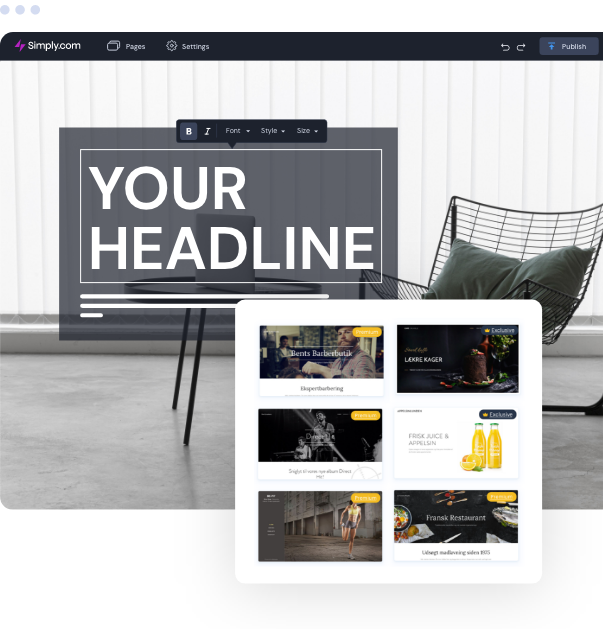How Professional Website Design Helps Build Trust with Your Audience
Modern Site Style That Records Focus and Transforms
In an increasingly digital landscape, modern internet site design has actually arised as an essential aspect in catching customer interest and driving conversions. By strategically using aesthetic pecking order, receptive layouts, and engaging interactive elements, designers can develop experiences that not only bring in visitors yet also assist in meaningful communications. Efficient call-to-action techniques play a crucial duty in directing individuals toward desired outcomes. As we discover these necessary parts, it comes to be clear that recognizing their interplay can considerably impact a site's efficiency and customer satisfaction. What are the key components that genuinely make a difference?
Importance of Visual Hierarchy
Visual pecking order is a critical element in site style, as it guides individuals' attention and enhances their general experience. By strategically arranging material, developers can guide users to the most crucial information first, thereby boosting engagement and enhancing functionality.
Including a logical circulation in material arrangement is important; as an example, positioning the most essential details on top of a web page fosters instant acknowledgment. Furthermore, regular usage of typography, such as differing font dimensions and designs, aids develop a clear web content framework. This organization not only aids in navigating but additionally develops trust, as individuals really feel more comfy when they can quickly locate what they are looking for.
Eventually, a well-executed aesthetic pecking order not only improves visual charm yet likewise dramatically impacts customer habits. By focusing on necessary components and ensuring a seamless experience, developers can efficiently transform site visitors right into consumers, enhancing the relevance of this fundamental style concept in modern-day site advancement.
Responsive Layout for All Instruments
Creating a seamless experience across various gadgets is crucial in today's digital landscape, where customers access internet sites from desktops, tablets, and smart devices alike. Responsive layout is a critical technique that guarantees websites adjust fluidly to various screen dimensions, positionings, and resolutions. By utilizing flexible grids, images, and CSS media queries, designers can create designs that keep aesthetic integrity and capability, despite the gadget being used.
The value of responsive style expands beyond looks; it directly influences individual involvement and conversion prices. A website that works well on all devices urges longer visits and reduces bounce prices, as individuals are more likely to engage with content that is easy to browse. Search engines, specifically Google, prioritize mobile-friendly websites in their rankings, making receptive design a vital element of search engine optimization (SEO)
Integrating responsive style not only improves customer experience however additionally simplifies the development procedure. By creating a solitary site that functions across gadgets, companies can save time and sources contrasted to creating different mobile and desktop variations. Inevitably, receptive layout is a fundamental technique for modern website style, making sure access and fulfillment for all customers, regardless of their gadget.
Involving Interactive Elements
While a responsive layout prepares for a functional website, including engaging interactive aspects is crucial for catching individual attention and promoting much deeper links. Website Design. Interactive elements, such as computer animations, tests, and clickable infographics, produce a more dynamic individual experience, urging visitors to spend more time on the website
Including interactive features can additionally lead individuals through complex info, making it less complicated to digest web content. Interactive sliders can highlight product variations, while embedded videos can offer demos or reviews that reverberate even more than static images or text. Gamification techniques, like benefits for engaging or finishing jobs with content, can boost user inspiration and retention.
Efficient use of interactive elements not just enhances the user experience yet can also bring about higher conversion rates. By making interactions interesting and pleasurable, businesses can grow a feeling of Going Here loyalty and depend on with their target market. It is crucial to stabilize interactivity with performance; excessively complicated attributes might hinder site speed, negatively affecting customer satisfaction. Eventually, incorporating properly designed interactive aspects can dramatically raise an internet site's efficacy, driving involvement and conversions in today's affordable electronic landscape.
Structured Navigating Practices
Reliable navigation is a foundation of any successful website, as it directly affects individual experience and web content accessibility. Streamlined navigating techniques guarantee that customers can quickly find information, improving their communication with the website. A well-structured navigation menu ought to be intuitive and simple, generally featuring a minimal variety of main categories to stay clear of frustrating visitors.
To achieve structured navigation, designers should focus on an ordered structure that logically arranges content. Implementing breadcrumb routes can supply users with context about their existing place within the site, permitting for seamless backtracking. In addition, making use of drop-down menus can efficiently conserve room while still offering accessibility to subcategories.
Responsive design is essential, as navigating ought to be functional throughout all tools (Website Design). Mobile users, in particular, advantage from touch-friendly food selections and collapsible areas that preserve use without endangering visual appeals

Efficient Call-to-Action Strategies
A well-crafted call-to-action (CTA) is essential for leading customers toward preferred end results on a web site, as it motivates them to involve with material or make a purchase. To maximize their performance, CTAs must be clear, compelling, and tactically positioned throughout the site.
First, utilize action-oriented language that communicates seriousness or worth, such as "Start," "Sign up with Currently," or "Case Your Price cut." This language not just encourages customers yet likewise sets clear expectations concerning the next actions.
2nd, consider layout components; CTAs must stand apart visually with contrasting shades, ample whitespace, and famous positioning. A button that is very easy to see and click boosts the probability of individual communication.
Furthermore, individualizing CTAs based upon customer actions or demographics can substantially enhance interaction. Tailored messages reverberate a lot more with users, driving greater conversion prices.

Verdict
Finally, contemporary internet site style stresses the integration of visual pecking order, receptive layouts, involving interactive components, structured navigation, and Check Out Your URL effective call-to-action methods. These components collectively improve customer experience, ensuring that visitors stay involved and encouraged to explore content even more. By prioritizing these layout principles, companies can dramatically boost customer retention and conversion rates, inevitably bring about better success in the electronic landscape. The continual advancement of website design emphasizes its critical role in effective online communication and marketing.
In an increasingly digital landscape, modern-day web site style has emerged as a crucial variable in capturing customer focus and driving conversions.Visual pecking order is a critical component in web site design, as it overviews users' focus and improves their overall experience.The relevance of receptive design prolongs past aesthetic appeals; it straight affects user involvement and conversion rates.Incorporating receptive layout not only boosts user experience yet additionally simplifies the advancement procedure. Eventually, receptive style is a fundamental approach for contemporary internet site style, making certain availability and satisfaction for all customers, regardless of their tool.